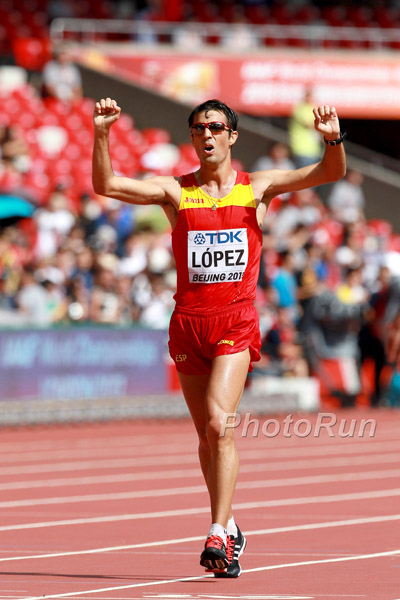And further down the list of finishers were the men of Greece, Mexico, Kazaakhstan, Portugal, Ecuador, Sweden, Argentina, Bolivia, Slovakia, Venezuela, Guatemala, Chile and Peru.
The DNF list included new WR-holder Yusuke Suzuki of Japan but all of it was wonderfully-wonderfully global nevertheless.
But that parade of nations and finishers had two major gaps.
And the explanation for that situation is as divergent as it gets, too.
Russia wasn’t here because its national program had been too-too successful,
an ascent that got there for all the wrong reasons. Once hailed as the greatest of
walking wizards, Russian coach Viktor Chegin now is persona non grata (along with his
athletes) in his sport these days, dragged down and out by the rampant doping
charges against him and his lineup of walkers that have mushroomed to saddening heights.
But turn the tables now.
Team USA wasn’t here in the 20K, either.
It was a first time, sadly, that’s ever happened in the men’s 20K at
Worlds – because it’s had no success at all getting anyone under the qualifying
standards. (John Nunn, doing the 50K, is the lone American male racewalker here;
Maria Michta-Coffey and Miranda Melville are in the women’s 20K.)
So, Americans dedicated to the racewalking game keeping asking themselves, “If they (our Canadian neighbors) can do it (as, too, our Mexican neighbors to the south have been doing it for years and years and years) why-why-why in heck can’t we?
Well, the explanations are lengthy and obvious.
There are no serious USA national development plans. There is no viable high school
component; Maine is the only state with racewalking as a standard, scoring event;
New York does it, but only for its girls.)
The Junior Olympic programs around the nation are hit-and-miss.
There are just a handful of knowledgeable coaches and no plans to import any
(as China, Korea, Japan, etc. are now doing.)
And it goes on and on.
Saddest, perhaps, of all, is the scenario when some genuine young prospects arrive on the American scene, reach performance levels indicating that they have the potential to compete with the best of the best, then simply disappear from the scene for reasons few can ever explain.
One perfect example: Trevor Barron, the Pittsburgher who finished in the top half of the
field at the 2012 London Olympic Games, and crossed the line in 1:22:46, faster than any American had ever gone the 20K at the Games.
All this at age 19.
But he’s been only intermittently seen since graduation from Colorado College and it’s all guesswork if he’ll ever show up again on a racewalk starting line.
One more example: Tyler Sorensen, the Californian who lowered the American junior 10K record to 41:23, brilliant going four years ago, but has virtually vanished from the sport since heading off to Stanford.
The NAIA schools (most all are small ones) do a solid job of it (hey, just ask U. of B.C.’s Ben Thorne) but NCAA coaches develop apoplexy when the subject of racewalking is even mentioned.
A ripe group for recruiting to the racewalking game would seem to the mid-level distance runners (say 4:25 miles, 16-minute 5K men, 2:40 marathoners) likely never to reach greatness that way but who might easily morph into solid, serious racewalkers.
But nobody’s mounting a serious reach-out to them, either.
So there we are, folks.
As racewalking continues its remarkable, multi-continental, mega-nation advances,
Team USA keeps walking through the quicksand.
 Miguel Lopez, Espana, photo by PhotoRun.net
Miguel Lopez, Espana, photo by PhotoRun.net




















